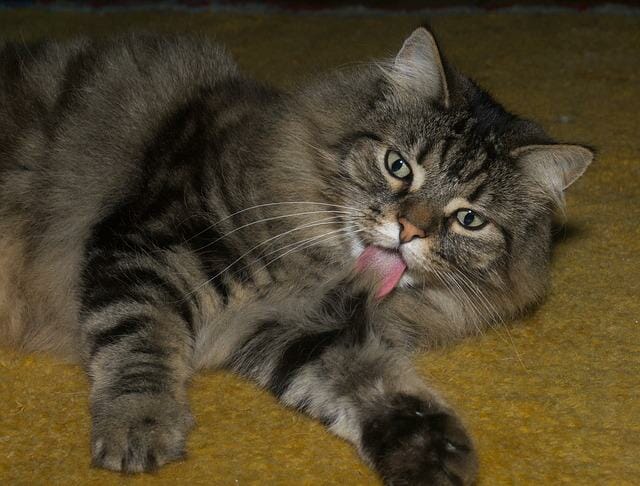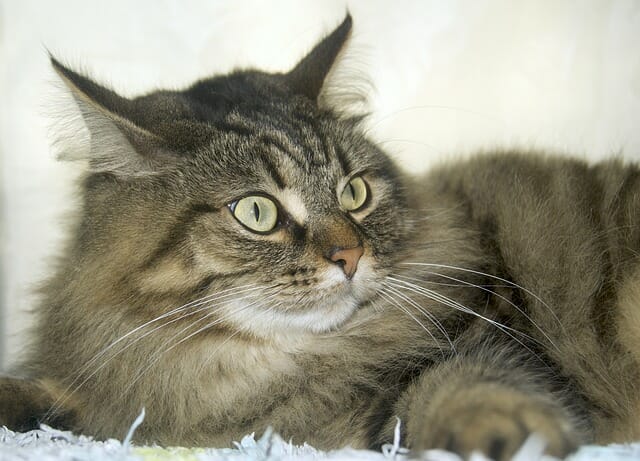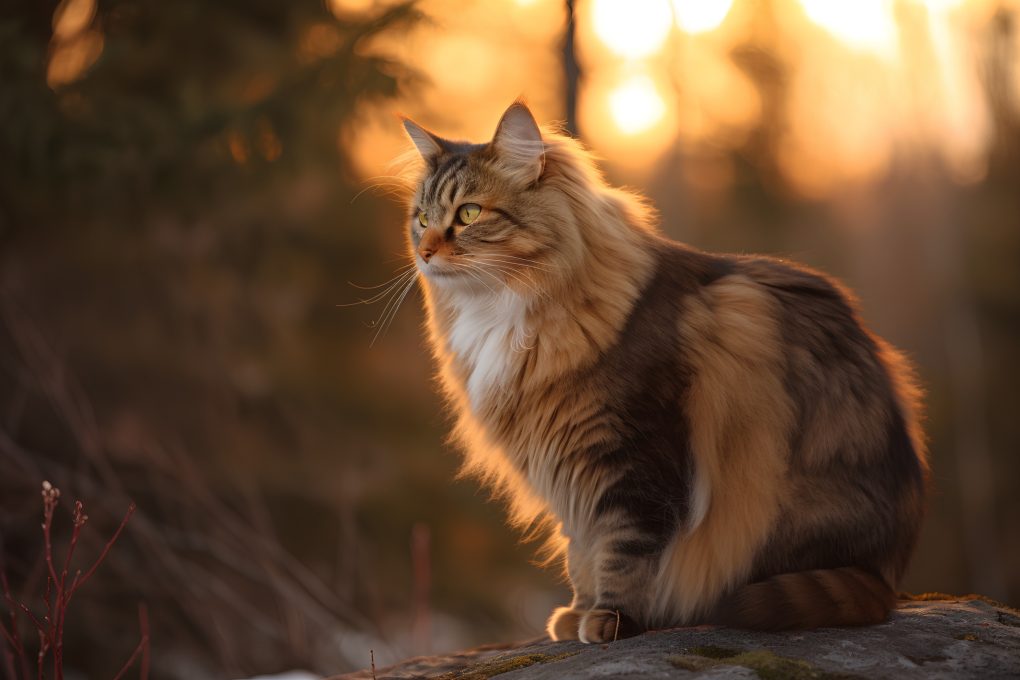Are Norwegian Forest Cats Vocal: A Guide to Understanding Why Norweigan Forest Cats May Get Vocal
No, Norwegian Forest cats are not particularly vocal compared to some other breeds of cats. While they may occasionally meow or make other vocalizations to communicate with their owners, they are generally known for being quiet and reserved.
That being said, every cat has its personality, and there may be individual Norwegian Forest cats who are more vocal than others. Also, like any cat, they may become more vocal in certain situations or communicate certain needs or desires.


Table of Contents
Reasons Norweigan Forest Cats Get Vocal
Hunger
When a cat is hungry, it may vocalize to communicate its food needs. Hunger can cause discomfort and anxiety in cats, and vocalizing can be a way to relieve that discomfort. In the case of Norwegian Forest cats, their loud and persistent meows are often an effective way to capture their owner’s attention and let them know they need to be fed.
Moreover, Norwegian Forest cats are known for their large size and muscular build, and as a result, they require more food than some other cat breeds. They have a high metabolism and can burn calories quickly, so they may need to eat more frequently. This increased need for food may also contribute to their vocalization when hungry.
If your Norwegian Forest cat is meowing due to hunger, establish a regular feeding schedule for your cat, and stick to it as closely as possible. This will help your cat learn when to expect food and may reduce their meowing for food outside these designated feeding times.
Ensure your cat gets a balanced and nutritious diet that meets its nutritional needs. Talk to your veterinarian about your cat’s best diet based on age, activity level, and overall health.
Give your cat access to plenty of fresh, clean water. Dehydration can cause hunger-like behaviors, so ensuring your cat is well-hydrated can help reduce meowing. If your cat is still meowing for food, try offering healthy treats, such as small pieces of cooked chicken or fish, to help satisfy their hunger without overfeeding them.
Attention
When a Norwegian Forest cat wants attention, it may meow loudly or persistently to get its owner’s attention; it may rub against its owner’s legs or climb onto its lap to seek physical contact. They may also follow their owner around the house, trying to engage them in play or seeking affection.
Norwegian Forest cats are intelligent and intuitive and often know when their owners are busy or preoccupied. When they sense that their owner is not giving them enough attention, they may become vocal and try to get their attention through meows, purrs, or other sounds.


It’s important to note that attention-seeking behavior is not limited to Norwegian Forest cats and is common among many cat breeds. Cats are social animals and need interaction with their owners to feel happy and fulfilled. Lack of attention can lead to boredom and anxiety, manifesting in destructive behavior or other negative habits.
If your Norwegian Forest cat is vocalizing for attention, providing them with the interaction and affection they need is essential. Spend quality time with your cat, engage them in play, and offer them plenty of physical contact and affection. This can help to strengthen your bond with your cat and ensure they are happy and healthy.
Playfulness
When a Norwegian Forest cat wants to play, it may meow loudly, chirp, or make other playful sounds to get its owner’s attention. They may also try to initiate play by bringing toys or other objects to their owner or jumping and running around the house. These cats have high energy levels and may play for extended periods.
Norwegian Forest cats are intelligent and curious animals that need mental stimulation to stay happy and healthy. Play is an important part of their daily routine and can help prevent boredom and anxiety. Vocalization during play can allow them to express their enjoyment and excitement and encourage their owners to continue engaging them in play.
It’s essential to provide your Norwegian Forest cat with plenty of playtime and activities to stimulate them mentally and physically. Interactive toys, such as laser pointers, feather wands, or puzzle toys, can provide excellent entertainment for these cats. Playing with your cat can also help strengthen your bond and provide quality time together.
Stress or Anxiety
While Norwegian Forest cats have a friendly and sociable nature, they can also experience stress and anxiety under certain circumstances. For example, when feeling stressed or anxious, these cats may vocalize their discomfort and seek comfort from their owners.
Stressors for Norwegian Forest cats can include changes in their environment, such as moving to a new home or introducing new pets, loud or sudden noises, unfamiliar people or animals, or changes in their daily routine. These situations can cause anxiety and fear, leading to vocalization to express their distress.
When a Norwegian Forest cat is stressed or anxious, it may vocalize in a high-pitched or urgent tone, meowing or yowling more frequently than usual. It may also hide or avoid contact with its owner or become aggressive or destructive.
To help reduce stress and anxiety in Norwegian Forest cats, it’s important to identify and address the source of the problem. Providing a calm and secure environment for your cat, including a safe and comfortable hiding place, can help to reduce stress. Gradually introducing changes, such as new pets or people, can also help to ease anxiety.
Additionally, providing plenty of mental stimulation can help to distract your cat from stressful situations. For example, if your Norwegian Forest cat continues to vocalize or exhibit other signs of stress or anxiety, it’s essential to consult with your veterinarian. In addition, they can help determine if underlying health issues contribute to your cat’s behavior and recommend appropriate treatment options, such as medication or behavior modification.
Illness or Pain


Norwegian Forest cats, like all animals, may vocalize when they are ill or experiencing pain; vocalization can be a way for them to communicate their discomfort to their owners, and it’s important to pay attention to these vocalizations and take appropriate action to address any underlying health issues.
When a Norwegian Forest cat is ill or in pain, it may vocalize in a low, mournful tone or meow more frequently than usual. They may also show other signs of discomfort, such as lethargy, loss of appetite, or avoiding physical contact.
If you suspect your Norwegian Forest cat is ill or in pain, it’s important to consult with your veterinarian. They can perform a physical examination and recommend appropriate diagnostic tests, such as blood work or imaging, to identify underlying health issues.
Depending on the underlying cause of your cat’s vocalization, your veterinarian may recommend various treatments, such as medication, changes in diet, or surgery. It’s important to follow their recommendations closely and provide necessary follow-up care to help your cat recover.
In addition to medical treatment, providing a comfortable and supportive environment for your Norwegian Forest cat can help to ease their discomfort. Providing a quiet and warm place to rest, offering plenty of water and nutritious food, and limiting physical activity can help support your cat’s recovery.
